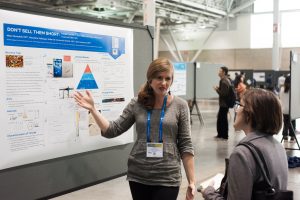
Name:
Alison Clare Domzalski
Department:
Project Title:
Don’t Sell Them Short: There’s More to Bacterial Natural Products Than Antibiotics
Website:
http://www.hunter.cuny.edu/chemistry/faculty/Kawamura/group/ak-group-home
Alison enjoyed a brief career as a forensic biologist at the NYC Office of the Chief Medical Examiner. But it was her passion for organic chemistry, cultivated over years spent teaching, that lured her back to school to study natural products chemistry with Dr. Akira Kawamura. When she’s not at the bench at Hunter College, she enjoys camping in the wilderness, photographing alien landscapes, and mentoring young scientists both locally and abroad. She volunteers to promote curiosity in biology and chemistry through community outreach projects with the Costa Rican organization Centrosocioambiental Osa. Recent workshops taught were on stereomicroscopy of insects and distillation of plant essences.
Project
Recent genomic studies of microbiomes have revealed an overwhelming number of biosynthetic genes of unknown function. Most of these “cryptic” genes are not expressed in laboratory monocultures of individual microbes. Thus, there remains untapped potential for natural products discovery. We employ mixed culturing, by harvesting bacterial communities from natural sources, as a simple yet powerful approach to awaken “cryptic” genes. Our preliminary study demonstrated that arrays of metabolites could be induced in bacterial cultures upon environmental cues, such as surface adhesion. Using this distinctive culturing system, we screen, identify, and isolate inducible bacterial metabolites, which are characterized structurally and biologically. This study reveals previously overlooked signaling molecules that are exchanged only in specific social contexts of cultures as identified by bacterial community analysis. Characterization of such factors will open new opportunities to develop molecular agents to control bacterial behaviors for biomedical and environmental applications, showing promise for interventions beyond antibiotics.
I am very grateful to be a recipient of the Provost’s Pre-Dissertation Research Fellowship for the Sciences. I am a Ph.D student in the natural products chemistry lab of Dr. Akira Kawamura at Hunter College. Our lab identifies chemical “words” (metabolites) spoken by bacteria with the goal of developing molecular agents to control the social behaviors of bacteria for biomedical and environmental applications.

This summer proved very fruitful for the project. On June 29, 2018, I successfully defended my second level exam and project proposal to my interdisciplinary committee, and on July 5, I officially became a Biochemistry Ph.D candidate. Before and after my proposal defense, I conducted valuable experiments with recently acquired technical knowledge, and I disseminated our results at four conferences:
- New York Academy of Sciences (NYAS) Chemical Biology Discussion Group Year-End Symposium in New York, NY
- American Society of Microbiology (ASM) Microbe Conference in Atlanta, GA
- Nature Conference on Chemical Biology at NYU, New York, NY
- American Chemical Society (ACS) Annual Meeting, Boston, MA
At ASM Microbe, I secured collaborations with microbiologist Dr. Bradley S. Stevenson of the University of Oklahoma and molecular biologist Dr. Athenia Oldham of the University of Texas of the Permian Basin, who will biologically characterize compounds that we have isolated from environmentally-sourced bacterial mixed cultures. While our lab has already isolated several interesting chemical “words” from bacterial communities, thanks to colloborations like these, we are now beginning to understand their biological relevance.

To determine the social contexts in which bacterial “words” are exchanged, it is crucial to identify the bacterial communities. We do this via 16S ribosomal RNA amplicon sequencing. This technique allows researchers to translate bacterial genetic sequences into phylogenetic information. In June, I learned to use the bioinformatics tool QIIME2 from Dr. Kawamura to interpret the sequencing data from our bacterial cultures.
I also learned how to interface with an open source computational tool for facilitating the identification of natural products, called the Global Natural Products Social Molecular Networking (GNPS) database. This allows researchers to share and organize mass spectral data into molecular networks. I now use this cutting-edge tool to conduct experiments wherein I culture bacterial communities over time, extract their metabolites at various growth periods, and then evaluate the stability of the resulting metabolic profiles.
For two weeks in August, I worked in the lab of microbiologist Dr. Monica Trujillo of Queensborough Community College. She taught me how to assay growth inhibition of pathogenic bacteria exposed to isolated bacterial metabolites. This makes a valuable contribution to our studies which assess the impact of our compounds on bacterial mass behaviors.
Attending conferences, presenting our data both orally and in writing, and learning new experiments has helped me advance our lab’s project very rapidly, and I have made strides in completing work for my dissertation. I would like to thank the Early Research Initiative for this wonderful opportunity as well as all the hard-working and innovative scientists that I have had the pleasure of meeting and working with at such an early point in my doctoral work.




